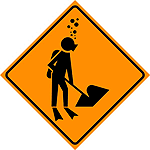|
| |

|
|
| < Prev. month |
Next month > |

|
This page under construction.
Here are some of the topics that will be covered in this chapter. More text and images will eventually be added to this section. Thank you for your patience.
|
- Early winter storms may remove the blades of giant kelp at the surface, but often leave the kelp stipes and floats, so that the deeper part of the kelp survives.
- Short-period, choppy, wind-driven storm waves do most damage to the kelp canopy (the part at the surface), but larger, long-period swell is more likely to remove entire kelp holdfasts, especially those growing where the bedrock is relatively soft (e.g. from Santa Cruz to San Mateo).
- Around the Monterey Peninsula, the kelp canopy (the amount of kelp at the sea surface) reaches a yearly minimum right after the first winter storms (typically in November), rather than later in the winter. This implies that the kelp canopy is already weak due to epiphytes and lack of nutrients, and that after its first "pruning" the canopy began to grow back during the winter months.
- In the most exposed coastal areas, kelp beds typically consist of bull kelp, which only lives between 12 and 18 months. The by late fall, the oldest bull-kelp plants are often heavily laden with hichhiking red and green algae, which add drag and make these plants more likely to be broken off by winter storm waves. Younger bull-kelp simply shed their blades under storm conditions, which reduces the drag of the waves and reduces the chance that the entire plant will be yanked up off the seafloor.
- Drift kelp at sea provides a localized habitat for seabirds such as phalaropes, which feed on the plankton associated with the masses of kelp. If the kelp washes up on the shore, it provides a bounty for intertidal scavengers, as well as attracting seabirds. Even the kelp that sinks into the deep sea provides a feast for deep-sea urchins and crabs.
- During winter storms, many animals living in the kelp canopy, such as kelp crabs, turban snails, and top snails, fall or crawl down to the sea floor, where they become more abundant during the winter months. However, once on the seafloor (which is more barren and provides less shelter in winter), these animals are more likely to be eaten by predators such as such as bat stars, sun stars, and young red octopus.
- Despite challenging winter conditions in the kelp beds, turban snails (e.g. Tegula pulligo and Tegula montereyi) may reach maximum abundance in December or January, when they gorge themselves on fragments of damaged kelp.
- With the first winter storm, young-of-the-year kelp rockfish and gopher rockfish leave the kelp beds and move to rocky areas in deeper water.
- Similarly, many mobile seafloor animals move away from the kelp beds, into deeper water with the onset of winter storms. Others, such as Callistoma snails, die off.
- Though the kelp canopy is torn up by storms and many understory algae are buried as sand moves from the beaches into the kelp beds, a few hardy red algae (e.g. corraline red algae, Pterosiphonia and Polysiphonis) and some brown algae (e.g. Desmarestia ligulata) living on the seafloor under the kelp benefit from increased sunlight and may even put on new growth in winter.
- Coralline red algae (e.g. Calliarthron and Bossiella), do especially well during the winter months, putting on much of their year's growth while the kelp canopy is thinnest.
- During less stormy years, red algae living beneath the kelp beds (e.g. Botryoglossum farlowianum, Cryptopleura violacea, Gigartina corymbifera, Rhodymenia spp.) may put on a growth spurt in December, as sunlight once again reaches the seafloor once the kelp canopy has been thinned by winter waves. However, these algae also run the risk of being buried by sand as it moves from the beaches into the kelp beds.
- In deeper rocky areas, strawberry anemones spawn in December.

|
|
